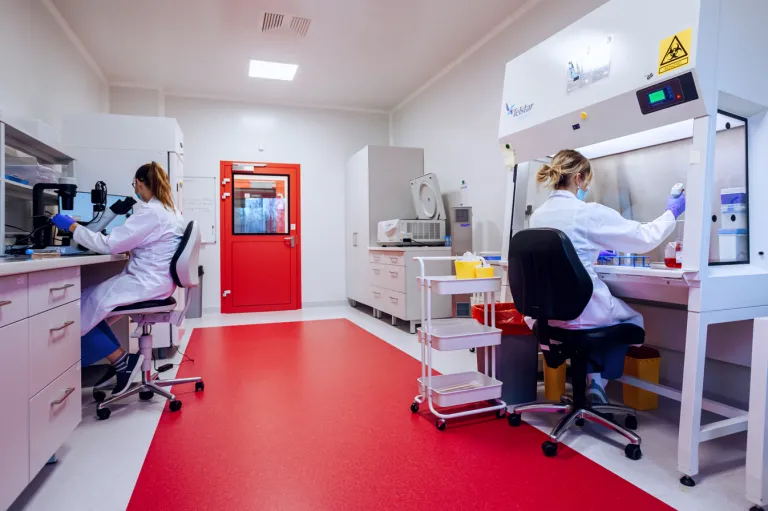Many myths related to cord blood banking are being propagated on the Internet. Although its collection is gaining popularity in Poland, many Parents still have doubts caused by repeated false information about stem cell collection and storage. So we have selected the most frequently reproduced myths and explained what the facts are.
Cord blood banking is not expensive
Many Parents are concerned that cord blood banking is a procedure available only to a select few. This is probably due to an often-repeated myth about the very high cost of storing a child’s stem cells. Recently, however, the fee system has changed and the monthly banking costs are currently around PLN 50. The one-time fee during pregnancy is currently only PLN 250. Many Parents choose to cover the cost of banking from the 500+ benefit, thus ensuring a secure future for their child. In addition, the Polish Bank of Stem Cells often organizes raffles in which the prize is free cord blood banking.
Proprietary stem cells can be used in therapy
The probability of using stem cells for therapy during our lifetime is 1 in 100. Not everyone realizes that cord blood stem cells can be used to treat both the child from whom they were collected and, if there is a tissue match, his or her siblings. Whether one needs one’s own material (autologous transplant) or from a donor (allogeneic) for treatment depends on, among other things. From the type of disease and its severity. It is the attending physician who makes the decision on the therapy to be used. For example, in the case of acute lymphoblastic leukemia, the use of one’s own stem cells is impossible, while in the treatment of cerebral palsy, for example, stem cells derived from the umbilical cord blood of the child from whom they were taken are an effective adjunct to treatment.
The amount of stem cells in cord blood is sufficient to treat older children
It is a matter of individual concern exactly how many cells will be obtained during childbirth. A large amount of blood is not always synonymous with a large amount of stem cells. Most often, about 75 ml of cord blood is collected. In turn, there are about 800 million cells per serving. It is believed that the dose needed for transplantation is approx. 20-25 million cells per kilogram of the recipient’s body weight. Thus, 1 serving is enough even for a 50-kilogram recipient.
After sample preparation, parents are always informed how many cells were isolated from their child’s cord blood. When we are dealing with an older child weighing more than 40-50 kg, the so-called “baby” can be used. Combined transplantation (co-transplantation). A portion of cells from cord blood is then matched with a portion from another source, such as bone marrow, umbilical cord or peripheral blood.
Cells from cord blood have greater regenerative capacity than marrow
Stem cells are contained in both bone marrow and cord blood. Many people then wonder what is the advantage of those derived from cord blood. Because of their lower immune maturity, they cause fewer complications after transplantation. Their regenerative capacity is 10 times greater than that of bone marrow. Due to the fact that the laboratory makes the stored stem cells of the child available “on the spot” if necessary, the time involved in preparing the material needed for transplantation is shorter, as it is not lost in the search for a bone marrow donor. In addition, by placing the stem cells at very low temperatures, the risk of damage and aging is much lower than is the case with bone marrow cells.
Cord blood collection does not affect the timing of the baby’s unbuttoning
According to current recommendations, the umbilical cord is cut after the pulse stops, which is no sooner than 60 seconds after the baby is born. The process of collecting cord blood has no effect on this moment. The medical staff, usually after consultation with the Parents, decides when the umbilical cord should be cut. The state of both the child and the mother is then taken into account. What’s more, the so-called late cord removal, which is increasingly being opted for by many Parents, is not a contraindication to cord blood donation. In such a situation, cord blood can be successfully collected in a volume sufficient for subsequent clinical use. This is blood that remains in the vessels of the umbilical cord and placenta after delivery and would otherwise simply be treated as postpartum “waste” and disposed of by the hospital.
A family bank, unlike public banks, provides access to your own stem cells stem cells
There are now both public and family banks. Unlike the former, at family banks, parents are assured that the stored material from their child’s cord blood can be used in the treatment of their family members. In the case of public banks, it is necessary to relinquish the right to the stored stem cells. For this reason, they can be used by any patient if necessary. Wanting to secure the future of your children, it is better to opt for a family bank to ensure that the stored material can be used at any time in the event of a possible illness of loved ones. Moreover, we are assured that the stored samples are of the best quality and contain valuable material.
Cord blood is used in Poland
In Poland, stem cell therapies are gaining popularity. Currently, stem cells from cord blood can already be transplanted at seven centers, while cord stem cells, which are mainly used in regenerative medicine, can be transplanted at ten. This is handled by m. in. centers in Lublin, Bydgoszcz or Poznań. What’s more, standard transplants are reimbursed in Poland. And new therapies related to the use of cord blood-derived stem cells used to alleviate symptoms of autism or cerebral palsy are not reimbursed.
By banking cord blood, you are investing in health and your family’s future. It is worth making this decision after knowing all the facts about stem cell storage. Any information heard from friends or read on the Internet should be verified with reliable sources. You can ask all your questions to our medical consultants here.
Rate this article:











